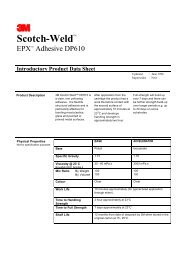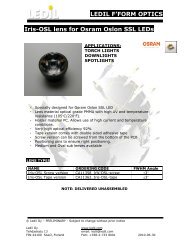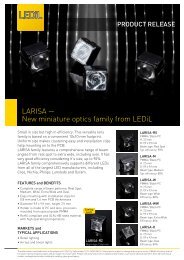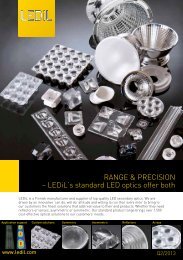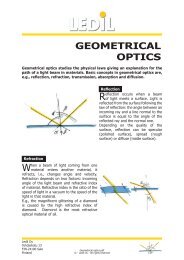TIR Lens Guide - Ledil
TIR Lens Guide - Ledil
TIR Lens Guide - Ledil
You also want an ePaper? Increase the reach of your titles
YUMPU automatically turns print PDFs into web optimized ePapers that Google loves.
What is a <strong>TIR</strong> lens<br />
Most typical lenses in the LEDiL standard product<br />
range are the cone-like lenses. These lenses are<br />
often called <strong>TIR</strong> lenses as a big part of their design<br />
relies on total internal reflection. Typically <strong>TIR</strong><br />
lenses are rotationally symmetrical designs which<br />
give a nice round light distribution. The lenses can<br />
be designed in arrays for multiple LEDs or have<br />
mechanical details included to aid mounting.<br />
<strong>TIR</strong> lens vs. reflector<br />
The basic working principle is the same for both<br />
<strong>TIR</strong> lenses and reflectors, but <strong>TIR</strong> lenses have more<br />
control over light. With reflectors a big part of the<br />
light doesn’t “touch” the reflector and this light can’t<br />
be controlled in any way. This difference can easily<br />
be seen with tight spot optics as reflectors usually<br />
don’t have as sharp a cutoff as <strong>TIR</strong> lenses.<br />
<strong>Lens</strong><br />
<strong>TIR</strong> lens’ typical light<br />
distribution has a<br />
sharp cut-off.<br />
Reflector<br />
Reflectors produce much<br />
softer cutoff even if the<br />
viewing angle is same.<br />
<strong>TIR</strong> = Total Internal Reflection<br />
<strong>TIR</strong> lens guide<br />
Relative intensity of LEILA-RS lens. Tight spot lenses<br />
produce typical “spike” of light with very tight cutoff.<br />
Relative intensity figure of REGINA spot reflector.<br />
Note how light is spread into wider angles.<br />
The information contained herein is the property of LEDiL Oy, Salorankatu 10, FI-24240 SALO, Finland and is subject to change without notice.<br />
Please visit www.ledil.com for additional information, such as the latest photometric files, 3D mechancial models, and application notes relating to handling, gluing and taping.



